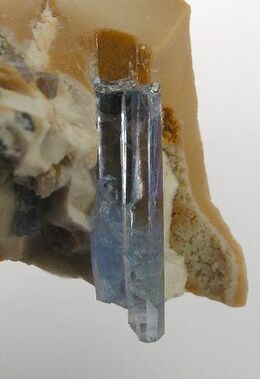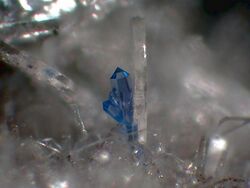Chemistry:Jeremejevite
| Jeremejevite | |
|---|---|
 | |
| General | |
| Category | Borate mineral |
| Formula (repeating unit) | Al 6B 5O 15(F,OH) 3 |
| Strunz classification | 6.AB.15 |
| Crystal system | Hexagonal |
| Crystal class |
|
| Space group | P63/m |
| Identification | |
| Color | Colorless, white, yellowish, blue, light yellow brown, aquamarine blue, rarely violet; colourless in transmitted light |
| Crystal habit | Prismatic |
| Cleavage | None observed |
| Fracture | Conchoidal |
| Mohs scale hardness | 6.5 – 7.5 |
| |re|er}} | Vitreous |
| Streak | White |
| Diaphaneity | Transparent |
| Specific gravity | 3.28 – 3.31 |
| Optical properties | Uniaxial (-) |
| Refractive index | nω = 1.653 nε = 1.640 |
| Birefringence | 0.0130 |
| Pleochroism | Colorless – light blue-violet |
| Other characteristics | Piezoelectric |
| References | [1][2][3] |
Jeremejevite is an aluminium borate mineral with variable fluoride and hydroxide ions. Its chemical formula is Al
6B
5O
15(F,OH)
3. It is considered as one of the rarest, thus one of the most expensive stones. For nearly a century, it was considered as one of the rarest gemstones in the world.[5][better source needed]
It was first described in 1883[6] as small, single crystals in loose granitic debris in Mt. Soktui, Nerschinsk district, Adun-Chilon Mountains, Siberia.[7] It was named after Pavel Vladimirovich Eremeev, Russian mineralogist, engineer and professor, who collected the first specimens (Jeremejev, German; 1830–1899).[3]
Properties
Jeremejevite is a mineral that shows pleochroic properties, which is an optical phenomenon in which the mineral's color appears to change depending on the angle at which it is viewed. Blue specimens from Namibia show a light cornflower blue to colorless to light yellow pleochroism, while yellow materials show light yellow to colorless pleochroism. This mineral is also piezoelectric, meaning that it would generate electricity when under mechanical stress.[7]
Mining and localities
Jeremejevite occurs as a late hydrothermal phase in granitic pegmatites in association with albite, tourmaline, quartz and rarely gypsum. It has also been reported in the Pamir Mountains of Tajikistan, Namibia and in micro-crystalline form at the Eifel district, Germany .[3] It was first found in facetable form in Namibia, which were blue-green pyramidal crystals up to 2 cm (0.79 in). Later, there was a new source revealed in Namibia, near Usakos in 2001.[7] Nowadays, most of the stones on the market are from that deposit.[5]
Jewelry industry
As an OH-end member, scientists have been able to synthesize jeremejevite, but only in micro-crystalline form, without fluorine. This synthesized variant of the mineral has no use in the jewelry industry.
Typically, faceted gems can reach up to 5 carats, but usually they range between less than 1 carat and 2 carats. However, new sources produced much larger faceted stones, the biggest faceted gem weighing 254 carats. This gem was found in Sri Lanka in 1990.
Even though jeremejevite is a relatively durable stone, it should not be cleaned using ultrasound cleaning or steaming; the stone usually contains liquid inclusions, which could shatter the stone if cleaned using these methods. It is recommended to clean them with warm water, a mild detergent, and a soft brush instead.[7]
Due to its high value and rarity, it is considered a collectors' stone, who purchase it in mineral form, hence only a few specimens had been faceted so far.[5]
References
- ↑ Jeremjevite on Mindat.org
- ↑ Jeremejevite on Webmineral.com
- ↑ 3.0 3.1 3.2 Handbook of Mineralogy
- ↑ Warr, L.N. (2021). "IMA–CNMNC approved mineral symbols". Mineralogical Magazine 85 (3): 291–320. doi:10.1180/mgm.2021.43. Bibcode: 2021MinM...85..291W. https://www.cambridge.org/core/journals/mineralogical-magazine/article/imacnmnc-approved-mineral-symbols/62311F45ED37831D78603C6E6B25EE0A.
- ↑ 5.0 5.1 5.2 "Rare Jeremejevite Gems at AJS Gems". https://www.ajsgem.com/articles/rare-jeremejevite-gems.html.
- ↑ Damour A. Note sur un borate d'alumine cristallisé de la Siberie. Nouvelle espèce minerale // Bulletin de la Société minéralogique de France. 1883. 6. N 1. P. 20-23.
- ↑ 7.0 7.1 7.2 7.3 "Jeremejevite Value, Price, and Jewelry Information" (in en). International Gem Society. https://gemsociety.org/article/jeremejevite-jewelry-gemstone-information.
 |


